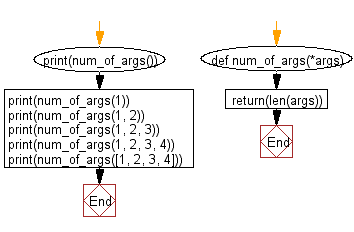Python: Count the number of arguments in a given function
Function Argument Counter
Write a Python program to count the number of arguments in a given function.
Sample Solution:
Python Code:
# Define a function named num_of_args that takes a variable number of arguments (*args).
def num_of_args(*args):
# Return the number of arguments passed to the function using the len() function.
return(len(args))
# Test the function with different numbers of arguments and print the results.
# Test case 1: No arguments
print(num_of_args()) # Expecting 0
# Test case 2: One argument
print(num_of_args(1)) # Expecting 1
# Test case 3: Two arguments
print(num_of_args(1, 2)) # Expecting 2
# Test case 4: Three arguments
print(num_of_args(1, 2, 3)) # Expecting 3
# Test case 5: Four arguments
print(num_of_args(1, 2, 3, 4)) # Expecting 4
# Test case 6: One argument (a list)
print(num_of_args([1, 2, 3, 4])) # Expecting 1 (the list is considered a single argument)
Sample Output:
0 1 2 3 4 1
Explanation:
Here is a breakdown of the above Python code:
- Function definition:
- The code defines a function named "num_of_args()" that takes a variable number of arguments (*args).
- Return Statement:
- The function returns the number of arguments passed to it using the "len()" function.
- Test cases:
- The function is tested with different numbers and types of arguments using print(num_of_args(...)).
Visual Presentation:
Flowchart:

For more Practice: Solve these Related Problems:
- Write a Python program to count the number of arguments a function accepts using introspection.
- Write a Python program to determine both the default and non-default argument counts of a given function.
- Write a Python program to inspect a function’s signature and return the total number of parameters.
- Write a Python program to utilize the inspect module to retrieve and count the arguments of a function.
Go to:
Previous: Write a Python program to replace all but the last five characters of a given string with "*" and returns the new string.
Next: Write a Python program to compute cumulative sum of numbers of a given list.
Python Code Editor:
Have another way to solve this solution? Contribute your code (and comments) through Disqus.
What is the difficulty level of this exercise?
Test your Programming skills with w3resource's quiz.
